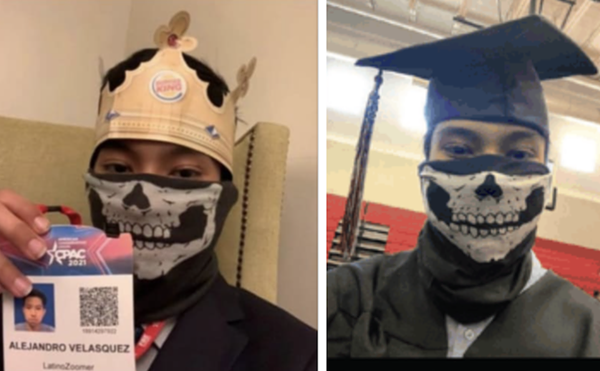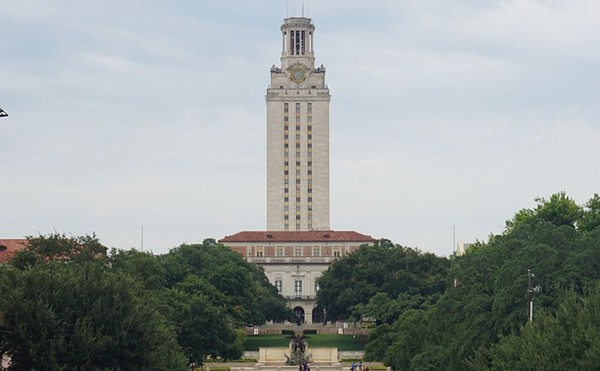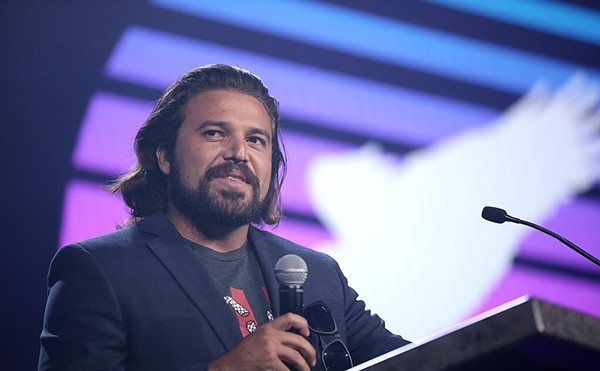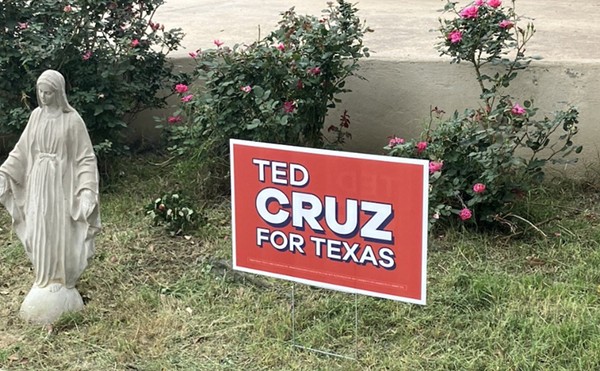Forget academia. Race isn’t a social construct; it’s a social amorphousness. As you hold it contemplatively between skull and hand-heel, it changes from biological issue to philosophical concept. Squeeze it and it will narrow to an impermeable class barrier. Blow on it, and it diffuses into clouds of pride and hate. Put it in your carry-on luggage; eight hours later it will be inside-out.
But really, we can’t touch Race. Race, or more often, its byproduct Racism, touches us. As American eyes adjust to the new dawn over a borderless nation threatened by terrorism and rage-filled rhetoric, the vagueness of Race T-bones us yet again. Don’t worry: we airbags at the Current are here for you. Read on, brothers and sisters.
SOME BLACKS PREFER RACISTS
When the state Republican convention’s dark carnival rolled through town last June, my thumbs felt a-pricking. Then I stumbled upon the big-tent party’s sideshow freaks in a premier edition of The Black Republican magazine.
God bless the National Black Republican Association. And I say that in the same way I’d say “God bless this mess” walking through a hutong in Hong Kong, the air like a dirty dry sauna, the alley tangled with jack hammers, bowls of tragic sea creatures, and skinny cats who wish everyone harm. And though I can accept Gallup figures that say 7 percent of blacks make their home in the Grand Old Party (that many?), I will believe Frances Rice, chairwoman of the 1,000-member NBRA, is vapid and foolish until the day I die. Rice insists that the Democrats are a bunch of racists. And Republicans are actually the party of tolerance.
“The Democrats, being the nasty people that they are, focus on keeping alive a false image of who they are,” the black Atlanta native says. “We were fighting Democrats when they turned dogs and firehoses on us and we’re fighting them today.”
Makes sense if you, like the NBRA, selectively ham up Republicans’ good deeds and the Dixiecrat-turned-Democrat misdeeds over 150 years and view the GOP as the teats through which the milk of human kindness is everflowing. Dammit, it’s true, Abe Lincoln was a Republican and his anti-slavery policies set it off with the Southern Democrats. Yes, Democrat Hilary Clinton made a Ghandi-as-gas-station-attendant joke in 2004. And her husband chillaxed while the Hutus hacked away a million Tutsis in Rwanda. But Rice’s little scorecard for offenses against the black diaspora high-jumps over Ronald Reagan, who happily played Sun City when everyone else imposed sanctions on South Africa during Apartheid. She applauds President Bush’s response to Hurricane Katrina (praise which prompted six NBRA boardmembers to resign last year). And she gave me cauliflower ear when she said Martin Luther King Jr. was a Republican!
“To suggest that Martin could identify with a party that affirms preemptive, predatory war, and whose religious partners hint that God affirms war and favors the rich at the expense of the poor, is to revile Martin,” said the Reverend Joseph Lowery, former president of the group MLK helped found, the Southern Christian Leadership Conference. Lowery spoke with the Washington Post last month, after the NBRA bought revisionist radio ads that even a candidate featured in The Black Republican denounced.
(For the record, MLK Jr. voted for JFK and LBJ. MLK Sr. was a Republican until RFK helped MLK Jr. get out of jail, and to repay the party, King’s father got out the black vote, issuing in 40 years of romance, and the occasional racist joke from junior senators.)
GHETTO SCANDALOUS
In 1993, Ted Danson appeared in blackface at a New York Friars Club roast for his then-girlfriend Whoopi Goldberg. Danson and Goldberg had cooked up the idea to mock all the racist hate mail they’d received since getting together by lampooning the most offensive racial stereotypes.
Nobody got it. The only lingering impression was of Danson in top hat and minstrel makeup, with outrageously thick, painted lips, throwing around the word “nigger” like it was some new kind of showbiz salutation. All the bigotry implied by a blackfaced Al Jolson hamming up “My Mammy” in the 1920s was brutally rubbed in the public’s face.
Danson, with Goldberg’s encouragement, had ignored one of the fundamental rules of comedy: Steer clear of mocking historically oppressed cultures, unless you belong to that culture yourself. Granted, it’s a rule that’s been violated by the likes of Don Rickles, Lenny Bruce, and Sarah Silverman. But the unemployment lines are filled with misguided Caucasians who foolishly tried to get laughs at the expense of blacks and Latinos.
Steve Lyons is a prime example. Lyons, a former major-league baseball player who worked as a color (but apparently not colorblind) commentator for Fox during this year’s American League playoffs, saw his network-broadcasting career come to an abrupt end on October 13 after engaging in a mindless broadcast-booth routine with Lou Piniella, a veteran manager who also happens to be Latino.
It all began when Piniella said that Oakland’s Marco Scutaro couldn’t be expected to maintain his torrid hitting pace any more than you could expect to find a wallet simply because you found one a few days earlier. He also used a couple of Spanish phrases, to which Lyons responded, with buffoonish exaggeration: “Lou is habla-ing some Español and I’m still looking for my wallet. I don’t understand him, and I don’t want to sit close to him now.” The implication, at least to Fox executives, was that Piniella, as a Latino, was a likely wallet thief.
After his firing, Lyons told ESPN Radio that he “didn’t know `Piniella` was of Spanish descent.” It was a credible comment, given both Lyons’s cluelessness and the fact that Piniella has never been identified as part of baseball’s rapidly growing Latino community. For his part, Piniella took no offense, and praised Lyons’s work in the booth.
The kind of zero-tolerance policy demonstrated by Fox can be traced to the whopper of all embarrassing racial jokes. In 1976, while on board Air Force One, Agriculture Secretary Earl Butz uttered the following: “I’ll tell you what the Coloreds want. It’s three things: first, a tight pussy, second, loose shoes, and third, a warm place to shit.” If you can get past the fact that “Coloreds” was by 1976 an archaic term primarily uttered by Ku Klux Klan members, the joke itself played into all the post-Reconstruction stereotypes of African Americans as libidinous, shiftless dolts.
Butz resigned under pressure a month before the ’76 presidential election, and some political analysts suggested that his gaffe made the difference in Gerald Ford’s narrow loss to Jimmy Carter.
In the post-Butz world, racial humor rarely surfaces overtly in politics, but it still appears in veiled form. One of the most talked-about political ads of this election year came from Bob Coker, Tennessee’s Republican nominee for the U.S. Senate. Coker’s Democratic opponent, Harold Ford, is attempting to become the first African-American senator in that state’s history. In a 30-second spot dripping with sarcasm, Coker’s campaign spotlights a series of voter comments designed to make Ford look like a shallow, soft-on-terrorism, pretty boy: “Harold Ford looks nice, isn’t that enough?”; “terrorists need their privacy”; and “so he took money from porn-movie producers. Who hasn’t?”
The part of the ad that attracted most attention, however, focused around a blonde Playboy Playmate who claimed she met Ford at a Playboy Mansion party. The commercial ends with her coyly whispering to Ford: “Call me.” The ad had the odious smell of Mandingo politics (“Vote for Ford if you’re in favor of him stealing all our white women”), but both Coker and his Republican defenders pleaded ignorance. Rush Limbaugh argued, with considerable vehemence, that the Playmate’s race was irrelevant, and that she was white simply because most Playboy Playmates are white.
One of the odder byproducts of America’s hip-hop revolution is that young whites increasingly mimic black culture, with an emphasis on broad caricature. In recent years, universities have experienced a proliferation of so-called “Ghetto Fabulous” parties, in which white students dress up in Afros, gold chains, do-rags, and mouth grills, and carry 40-ounce bottles of malt liquor in paper bags. The most recent “Ghetto Fabulous” debacle occurred in September at the University of Texas Law School, at a party attended exclusively by first-year students. By coincidence or design, no African American students were invited to a party designed to ridicule their culture.
As with Coker and Lyons, the offending law students seemed incredulous when their actions were criticized. They consistently stated that they were simply having fun and didn’t mean to insult anyone. Al Jolson surely would have argued the same thing.
E-ATTACKS ON ISLAM
The Current gets plenty of spam and email that doesn’t pertain to us, but early last month, I received an interesting batch of emails that quickly soured into an open insult forum.
The initial email was distrubuted by the Council on American Islamic Relations-San Antonio, and was a simple reminder for everyone on the mailing list to register to vote. The email was somehow distrubuted to a number of people that didn’t want to be on the list, who in turn began mass emailing back every recipient requesting removal. There were over a hundred emails by lunchtime. I wasn’t thrilled about the inconvenience either, but was much more dismayed by the boorish responses that took flight after people became aggravated. The worst opened with a vulgar mockery of the Arabic language greeting As-Salaamu Alaikum, which means Peace Be Upon You.
“Hey Everybody! Ass-a-slammin A-licky-cum to all you filthy cunts as well! Why don’t all you douch bag allah fuckers take your ramadan noodle holiday off and not spam everyone!”
I usually just mark my spam as junk mail and delete it. But apparently some assholes decide to hide behind e-anonymity and ruin e-harmony for everyone.
NOW IN ETHNICOLOR
Race and American film, much like race and just about any other human enterprise, have always gotten on more or less like two wary children forced unwittingly into a play-date by well-meaning parents. Matters, in such cases, tend to begin politely enough, but with the first feint at the most coveted toy in the pile (always Optimus Prime, in my experience), affectation is tossed aside, teeth come out, and the fragile house of cards collapses, is scissored into confetti, sprinkled to flashpoint with kerosene, and set gloriously aflame while being kicked, cursed at, and defecated upon. And so it goes.
The latest toy-robot grab, as it were, hit a few weeks ago, when a now-notorious celebrity snapshot embarked — as such snapshots have a peculiar way of embarking — on an ill-will tour of the internet, riding a wave of blog posts and hastily forwarded emails, leaving heated message-board discussions (and markedly few LOLs) in its wake. The photograph appears to be a production still from the in-progress filming of the Brad Pitt-produced biopic A Mighty Heart, depicting Angelina Jolie “in costume” for her role as Marianne Pearl, widow of slain Wall Street Journal reporter Daniel Pearl. Problem: Marianne is brown-skinned and of mixed Afro-Cuban and Dutch descent, and said costume for the rather light-skinned (if somewhat “exotic”-looking) Jolie includes artificially darkened skin and a wig of frizzy black hair. Yikes.
Pearl herself is reportedly happy with the choice; a vocal portion of the online community is understandably not — a Google search for the combined terms “angelina jolie” and “blackface,” for example, now yields significantly more results than it would’ve, say, in August. Time to supplant “Brangelina” with “Al-gelina Jolson-lie,” then, for lack of a less-clunky portmanteau pun?
Hollywood’s checkered race-relations record reaches back to the industry’s salad days — from D.W. Griffith’s three-hour-plus silent epic The Birth of a Nation (1915), widely recognized for both its undeniable contribution to filmmaking (critic James Agee likened Griffith’s now-standard cinematic innovations to the invention of the wheel) and its unrelenting racism (the film features a heroic Ku Klux Klan, argues for segregation, and is populated by black “villains,” largely portrayed by white actors) to 1927’s The Jazz Singer, the first feature-length “talkie,” notorious now for scenes of Al Jolson performing in blackface. Common sense (and a bit of blind faith in humanity) would seem to suggest that the “browning” of Jolie — who is Czech, English, and French-Canadian, among other bits — is a ham-fisted but reasonably innocent gaffe rather than an overtly bigoted jab at Pearl’s mixed heritage. More to the point, though, objectors argue that the face-painting dramatically outlines a larger issue: the paucity of meaty roles for non-white actors, made even more worrisome by the frequency of outside poaching.
Many of the most cringe-worthy such instances are softened by the excuse that they were made decades ago; for some, though, even historical context does little. Mickey Rooney’s ghastly, nigh-inexplicable turn as a bellowing and pervy Japanese landlord in Breakfast at Tiffany’s, for instance, is as horrifying as any World War II propaganda. Nearly as perplexing is Brian DePalma’s Cuban gangster tale Scarface, whose principal cast features precisely one Cuban actor (Steven Bauer); the rest, by and large, are spritz-tanned Italian Americans with painfully clownish accents. (By the time orange-tinted Robert Loggia and F. Murray Abraham appear onscreen, the willing suspension of disbelief must needs shift to DEFCON 1.) Other examples: Jeremy Irons, Meryl Streep, Glenn Close, and Winona Ryder as a Chilean family in the 1993 adaptation of Isabel Allende’s The House of the Spirits; Marlon Brando as Emiliano Zapata in Viva Zapata! (1952) and a Japanese interpreter in The Teahouse of the August Moon (1956); and the much-publicized row over Rob Marshall’s Memoirs of a Geisha (2005), which placed high-profile Chinese and Malaysian actresses in the film’s principal female roles. Even the single-tear “Crying Indian” from the circa-1970s “Keep America Beautiful” TV spots was a sham (dude was Italian).
Some non-white actors see opportunity in the sometimes-blurred ethnic lines of the casting process. Johnny Sanchez, an L.A.-based, Mexican-American actor-comedian who spoke with the Current in September `“Dos Reyes,” September 27-October 3`, says he used to get hired to play a variety of ethnicities, and liked it that way.
“My agent `would say` ‘Do you wanna go out on this thing for Habib or whatever?’” says Sanchez. “‘Yeah, absolutely, I can do the voices, everything. No problem.’ And then, he’d call me back later, ‘You know what? Um, they really want to try to keep it Indian …’ And I’m like, ‘Wha — that’s what acting is, you know? You jump into somebody’s skin, and you just become that.’ And it’s really changed, man unfortunately; they’re not doing that like they used to.”
That, then, is the question. At what point, is an actor simply that — one whose training has prepared him to play any part, no matter how different from himself? Clearly, there are extremes to be avoided. But can a Uruguayan guy play a Paraguayan character? Even further: Dustin Hoffman is not autistic; Daniel Day-Lewis is not paraplegic; Heath Ledger is not gay; Charlize Theron is not ugly. Should these roles be reserved for those who can “play” them without effort? Maybe sometimes, says Judith Moreland, who identifies herself as “an actor of color” and teaches acting and dialects at UCLA’s School of Theater, Film, and Television. She tells of a disabled actress friend whose frustration mounts with each able-bodied actor who nabs another of the few roles for which she might be considered.
“She puts all my `stereotypical-casting` complaints to shame,” Moreland says.
Moreland says she’s not offended by Jolie’s selection, but understands those who are.
“I think people who express displeasure about Angelina Jolie or other actors playing outside their race or ethnicity, it really stems from the fact that there’re just so few roles for people within the ethnicity that it’s just heartbreaking to see the role go to somebody else,” she says.
“In the best of all possible worlds, all roles would be open to everybody. In the real world, that’s not the case. If everybody could have access to everything, then these problems would just disappear and there would be no story.”
Meantime, enjoy Fake ’n’ Bake Angie.
TEED OFF
When my best friend in high school, Doretha, wore just a T-shirt and a pair of opaque tights to class, I had to side with the authorities and her fully dressed old-liner parents. There’s no place for a 6-foot, 200-pound pantless teen in a learning environment. But the wardrobe police go a stitch too far when they ban bilingual T-shirts from airports.
The August incident at JFK is just another example of our narrowing slit-eyed suspicions about 24-hour, all-circumstance multiculturalism. Raed Jarrar, an Arab/Muslim who works for Global Exchange in Washington D.C., was eating cheese and grapes outside the JetBlue boarding gate when he was approached by two Homeland Security inspectors. “People are feeling offended because of your T-shirt,” an inspector told Jarrar. And in interviews with Democracy Now! and on his blog, Raedinthemiddle.blogspot.com, Jarrar says he was also told to change, because wearing this clothing item at an airport was like “going to a bank with a T-shirt reading ‘I am a robber.’”
The offending message? “We will not be silent,” written both in English and Arabic. You know it wasn’t the phrase that caused alarm, but — like the controversy over bilingual ballots — the foreign language. Have we finally reached a place where the diversity-industrial complex has become so ineffective it cannot even protect multiculti messages screenprinted atop Beefy Tees? Is that tolerance I see face down on the pavement, tasting cement?
Yes, assimilation is back on the American agenda, and in the interest of safety, we are told we need to erect a monocultural identity, just as we did in the ’20s with the Emergency Quota Act and the National Origins Act, which combined efforts to keep out inferiors from Italy, Greece, Eastern Europe, and Asia, and sent a message to those who got in that “the day of indiscriminate acceptance of all races has ended”; that it’s not up to the host country to accommodate diversity: Immigrants and foreign speakers better integrate themselves. Or, like Doretha and Raed Jarrar, be grounded.
FORT SAM’S DARK HISTORY
On my desk rests a scummy Wilson premium-range golf ball representing, at least to me, the souls of 13 black men executed in secrecy less than a mile from my house.
I don’t mean to make light of the tragedy. It happened almost 90 years ago, on one brisk morning in December, while America was settling into its eighth month of World War I. A custom-made gallows sat on the banks of the Salado Creek, now part of Fort Sam Houston. The black soldiers had asked for the more noble death by firing squad, but having been found guilty of the severest form of mutiny, only the most ignominious punishment — hanging — was appropriate in the eyes of military law. Though disgraced, they still marched to the scaffold like true soldiers to their deaths, and sang a hymn until the floor dropped beneath them.
It was a secret death. As a journalist, this is what fascinates me most. The press knew that the death sentence had been imposed, but not that it had been confirmed. The night before, a rumor was seeded that the execution would be held elsewhere. In the morning, several hours after the men had been cut down and buried in the creekside, and the gallows razed, officials finally made a public statement. The Topeka Plainsdealer’s headline read, “Negro Soldiers Hanged Without Chance to Appeal to President.”
I don’t mean to paint them as martyrs. The 13 were among more than 100 black soldiers who’d mutinied four months earlier. They’d fought in the Philippines and Mexico, and beside Colonel Theodore Roosevelt, but as World War I broke out, they were transferred to guard training camps in Houston. After three weeks of burning discrimination and racial hostilities, a single black officer, bloodied by the Houston police, was enough to send the soldiers reaching for their guns. They killed 20 people.
The 1917 Houston Race Riot is historic because it was the first riot in which more whites died than blacks, because it was the largest court martial in U.S. military history, and because it forced the legislature to change the law to require presidential consideration of military execution appeals. In all, 19 men were executed; most of the rest were sent to Leavensworth Prison to serve life sentences.
In 1989, Celeste Bedford Walker, a descendent of one of the soldiers, brought the story to light, and life, through a theater production called Camp Logan. It’s been performed at more than 40 military bases as part of Black History Month programming.
The play’s producer, Mike Kaliski, says that after most performances audience members ask him “When are you going to make the movie?”
“That’s the main reaction,” Kaliski says. “And ‘How come I was a history major and I never heard about this?’ And ‘How come I was stationed at Fort Sam Houston for three years and didn’t know about it?’”
The short answer is that records surrounding the trial were sealed for more than 50 years. As far as the movie goes: It’s due this February. Funded by four major Texas foundations, Kaliski and San Antonio-based Bauhaus Media have nearly
finished filming the feature-length documentary.
Last week, I went looking for the place where the men were hanged. The military museum expert, John Manguso, led us to the approximate spot and pointed to an overgrown patch of land. He said it was about 100 yards in.
I entered the brush, tailed by a student cameraman from Trinity University. It was a Blair Witch Project moment. We walked, swerved, and ducked our way through overgrowth. We never found the creek, or anything else to mark the spot; just that golf ball, astray from the course across the way. In 1937, their bodies were moved to the National Cemetery.
“We just walked until we found another road,” I told Manguso.
“There’s supposed to be a creek in there,” he said, then shrugged and led us off-base.
Special thanks to: Robert V. Haynes, author of A Night of Violence: The Houston Riot of 1917, Fort Sam Museum, and Mike Kaliski.



















